Convallaria majalis
The first time I encountered lily of the valley, I smelled it before I saw it.
I was hiking near a forested swamp and was caught off guard by something that smelled pleasant. But aren’t swamps places for fetid odors and that delicate, lingering stench of standing water?
I wondered what it could be.
I followed my sniffer and spotted a large patch of green-leaved plants with stalks of hanging white flowers. It took half a moment to identify what I was seeing because absorbing plant and animal ID guides was a favorite pastime when I was growing up.

We link to vendors to help you find relevant products. If you buy from one of our links, we may earn a commission.
These white flowers left an impression on me, and I knew they had to go in my family’s garden. It took some shopping (this was before smartphones and the “Everybody Gets a Website” age), but we acquired some and planted them. Beautiful, fragrant flowers, here I come!
Flash forward a couple of years and that little patch dedicated to lily of the valley grew into a huge swath of nearly uncontrollable green.
It took a few seasons of dedicated removal, but we did finally curb the lily of the valley, and added some plastic barriers to prevent it from spreading more in the future.

It’s a beautiful plant with a delightful and aromatic scent, but adding it to the garden without the right preparation can lead to major headaches in the future. Let’s get into what lily of the valley is all about, and how to add it to your yard and garden with minimal future fuss.
What You’ll Learn
What is Lily of the Valley?
Botanically known as Convallaria majalis, lily of the valley grows naturally throughout the northern hemisphere in Europe, Asia, and North America. Also known as May bells, May lily, muguet, Mary’s tears, and Our Lady’s tears, the plant is highly scented flowering herbaceous perennial that normally grows in woodland and forested settings and in cooler, temperate regions.

C. majalis is a perennial plant. Two basal leaves grow from the ground and have a lovely flower stalk that pops from between, and it is adorned with up to 15 tiny, fragrant, bell-shaped flowers.
In cooler climates, the leaves can stay year-round, but they tend to shrivel and disappear during hot weather.
Lily of the valley is related to asparagus and grows through stolons and rhizomes, spreading out into huge colonies. This eagerness to spread is why it becomes so difficult to tame in the garden, unless properly restricted.
A Beautiful Standard
Many countries in Europe are awfully fond of lily of the valley. It’s a traditional (and expensive) bridal bouquet flower for weddings, including the bouquet used in the wedding of Prince William and Kate Middleton.
It’s the birth flower of the month of May, the time of year when lily of the valley is most often in full display. C. majalis is also the floral emblem of Yugoslavia, and is Finland’s national flower.
In Christian mythology, lily of the valley is said to have sprung from the ground where the Virgin Mary’s tears fell during the crucifixion. Alternatively, the plant is said to have sprung from the ground when Eve weeped for being kicked out of the Garden of Eden.
The attention to Christian mythology is what earns the plant its nickname, “Mary’s tears.” It also spawned a popular gospel tune by Willie Nelson. It isn’t my style, but hey, maybe you’ll enjoy it!
Beautiful But Poisonous
C. majalis is incredibly toxic. Seriously, every part of the plant is poisonous.
If you’ve got it in the yard or see it in the field, make sure children and animals abstain from eating the red berries, or chomping on the leaves or flowers.
The plant possesses nearly 40 different cardiac glycosides, an organic compound used to treat congestive heart issues. However, in anything but accurate and meticulously measured amounts, these toxins can prove to be deadly.
Lily of the valley produces a very rare amino acid as well, but this also contributes to the toxicity of the plant.
It’s better to be safe than sorry, so wash your hands after handling C. majalis to avoid accidental contamination.
Propagation
The plant generally spreads by forming large colonies through rhizomes (underground root-like stems) from which it produces upright spiky shoots (often called “pips”) at the end of the stolons during the summer.
The pips grow to into 6–12 inch stems and produce one or two 4–10 inch upright dark-green, spear-like leaves. All of the upright stems remain connected underground with other shoots and form large colonies if left unchecked.
Lily of the valley can also spread itself by producing orange-red berries with several seeds each.
However, the plant is self-sterile meaning that it requires multiple individual plants for pollination that aren’t connected by a rhizome/stolon structure. If a mass of Lily of the Valley is based from one single plant forming a colony, they’ll never grow berries.
Bloom Type
Lily of the valley produces strands (raceme) of five to fifteen small, bell-shaped flowers form as strands on top of a single stem above the leaves. Each bloom consists of six white (most common) or pink tepals. The flowers are extremely fragrant and are used in perfumes and potpourri.
As previously mentioned, these flowers can produce red berries with seeds if conditions are right.
Bloom Time
Lily of the valley typically flowers in early to mid spring for three or four weeks – which is significantly longer than most other spring perennials. In colder climates their bloom time may start later and extend into early summer.
This fragrant woodland perennial can also be used as a houseplant and be forced into blooming anytime of the year.
Growing Conditions
C. majalis is at its best in areas with a cool winter, although it will grow in USDA Hardiness Zones 2-9.
I spotted my first lily of the valley adjacent to a low, wet, and swampy patch in the forest. In the years since then I’ve encountered C. majalis in similar locations, and its preferred habitat tends to include a few key features:
- Shaded from the sun, often growing around the base of trees
- Rich, slightly acidic soil (pH 6-6.5), like the kind you’ll get from the forest floor
- Moist and well drained soil
- Space to spread out and grow
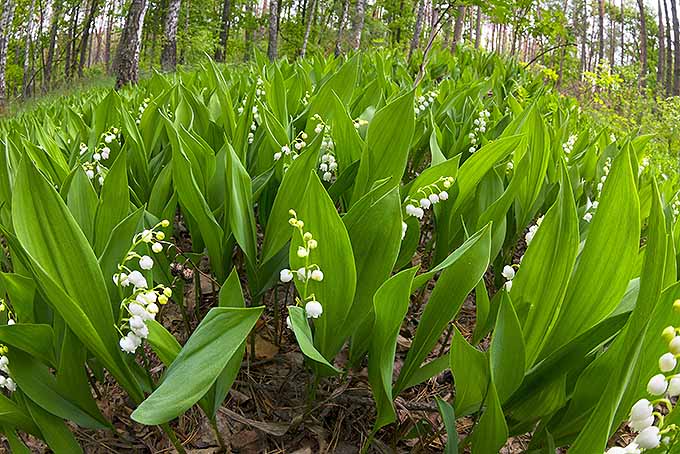
When we plant lily of the valley in our yards, it’s our goal to duplicate these conditions as best we can.
Planting for Success
This is one of those garden additions that grows like wild, but only when the right conditions are met. I’ve got a patch of it growing in my front yard underneath a yew hedge that is very unhappy, so believe me when I tell you: you want to make C. majalis happy.
Luckily, it’s easy to take care of that. Here are some things to keep in mind:
Light
Lily of the valley really digs its time in the shade. I think it does the best when it gets some morning light, maybe a few hours worth, and gets to kick back in the cool shade from about 10 a.m. onward.
Although it can handle more sun, in exchange, it needs much more water to perform. And in conditions that are too sunny, it simply won’t bloom.
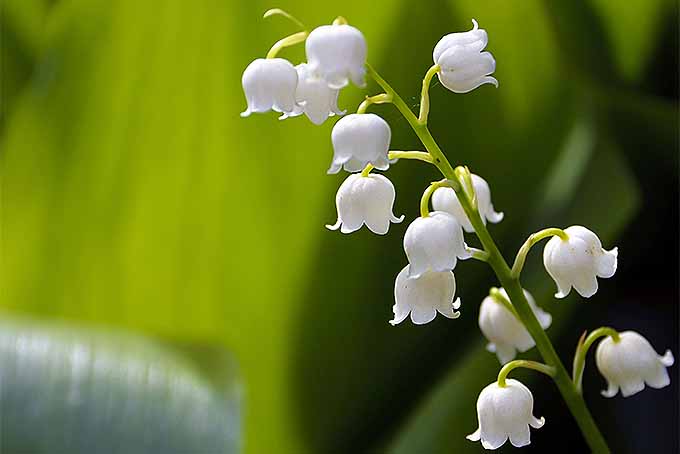
As the season carries on and we are bombarded with summer sun, expect to see your C. majalis wilting, getting crispy, and looking otherwise unpleasant. This is a natural and expected phase for the plant.
Simply cut back and remove the leaves once they’re more crispy than green to clean up the area.
Water
This plant is a fan of plenty of water and good drainage. Most of the wild lily of the valley I’ve encountered was growing on a slope where it received plenty of water runoff, but didn’t sit in stagnant pools.
If your location for lily of the valley is in a sunny locale, it’ll need plenty of extra water.
This was, I think, the primary failing of my own chunk of C. majalis. The front yard outside of my house is very dry and seemingly impossible to keep wet with a hose. I started using a soaker hose near the high point of summer and it worked well; just keep in mind that the longer your run of hose is, the weaker the pressure is going to be.
Try to keep your hose length at 25 feet or so. I purchased this product, available from Amazon, and have no complaints. I run a length of 20 foot hose from the spigot to the soaker hose and it works wonderfully.
Mulch aids in watering, but we’ll touch on that in the next section.
Nutrition
Don’t worry about spending lots of money on fancy fertilizers for lily of the valley!
A yearly addition of rich, organic compost is ideal for fueling C. majalis. Apply a nice layer of mulch, maybe 1 to 2 inches in depth, and let it break down naturally to supplement the soil around your lily of the valley.
Keeping it in Check
Simultaneously a pro and con of planting lily of the valley is its desire to spread out and grow. You’ve got a few options here…
1. Let It Go Wild
If you’ve got the space and conditions for it, let that lily fly wild! It’ll happily spread out and fill in whatever space it is given. This can be an attractive method to control erosion.
2. Keep It Fenced In
Use a quality garden edging to cordon off your lily of the valley, to keep it where it’s supposed to be.
This is an appealing choice because it guarantees a thick, healthy covering of C. majalis exactly where you want it to be, and prevents it from sneaking into new terrain.
3. Divide It Regularly
My method of choice is to allow lily of the valley to grow freely, then divide out the chunks I find undesirable in the early winter. November or December is ideal for doing this, but early spring works too.
At this point I’m able to shuffle the plants around to new locations in the yard, or I can offer extras to friends and family.

We don’t need to be too careful with the root stock here. It responds well to being divided, although it may take a full year before transplanted sections will produce flowers.
Find more tips on dividing lily of the valley here.
Cultivars to Select
Lily of the valley is often available in the spring at garden centers, usually sold in groups of pips or crowns.
Occasionally you can find small flats available for sale, but most often the plant is sold as a bare root stock; in big box stores you’ll find it near the berries and bulbs sold in boxes in the springtime.
Packages of 4 live plants or 10 pips are available from Burpee.
A larger cultivar called ‘Bordeaux’ is a nice option for the cutting garden. It has larger blooms, and sturdy, taller stems that max out at about 8 inches tall. Crowns in packages of 3 are available from Burpee.
Finally, if you’re looking for something a little different, try C. majalis ‘Rose.’ This pale pink cultivar is very rare, so get it while you can! Packages of 3 crowns each are available from Burpee.
It’s safest to soak the rhizomes in water for an hour or so before planting, to ensure a secure, permanent footing when they’re transplanted.
Managing Pests and Disease
You’ll be happy to learn that lily of the valley is rather robust and resistant to most pests. It’s even deer and rabbit resistant (likely thanks to the toxins found throughout the plant).
Except for a few weevils that may cause minimum cosmetic damage well after C. majalis blooms, the only creepy crawly that causes trouble is the slug.
A shallow plate with a sacrificial beer offering is usually enough to attract and dispose of slugs in most scenarios. All you need is a willingness to pour out perfectly good beer.
The main trouble afflicting lily of the valley is the potential for fungal problems. Most of these issues can be resolved by watering properly – remember to get the soil wet, not the leaves.
When problems do arise, they can usually be controlled with trusty neem oil.
The majority of fungal problems involve an unattractive looking leaf; it could have yellow halos, a yellow or brown color to the leaf veins, or black and brown spots.
Remember, lily of the valley problems are almost entirely relegated to fungal issues, so proper watering practices and careful neem and fungicide treatments will save the day.
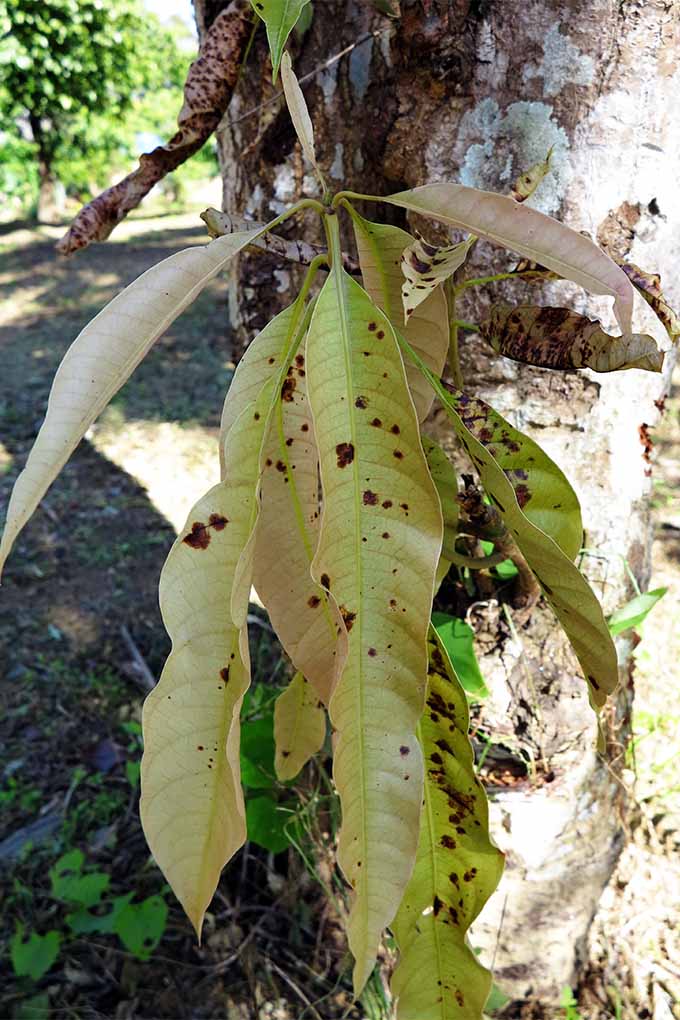
The only other disease common to this plant is southern blight. You can identify this major infection by the mustard-colored ball-shaped structures that it leaves at the base of the plant.
Unfortunately, the only solution here is to remove and destroy the plant entirely, to prevent it from spreading.
Quick Reference Growing Guide
| Plant Type: | Perennial | Flower Color: | White, pink (rare) |
| Native to: | Temperate Europe and Asia | Maintenance: | Minimal |
| Hardiness (USDA Zone): | 2-9, prefers cool winters | Tolerance: | Full sun in cooler climates |
| Bloom Time: | Spring | Soil Type: | Rich and moist, like that of a woodland |
| Exposure: | Partial to full shade | Soil pH: | Slightly acidic, 6.0-6.5 |
| Time to Maturity: | Plant in fall for spring growth | Soil Drainage: | Well-draining |
| Spacing: | Can be bunch planted | Companion Planting: | Hostas |
| Planting Depth: | 1/8 inch (seeds) or depth of root ball (transplants) | Uses: | Mass plantings, beds under tree cover |
| Height: | 12-22 inches | Attracts: | Bees and butterflies |
| Spread: | Densely packed rhizome-based growth | Family: | Asparagaceae |
| Water Needs: | Moderate, keep moist if possible | Genus: | Convallaria |
| Pests & Diseases: | Fungus and slugs | Species: | majalis |
Until the Next Time
Not every garden has room for C. majalis, but those who do are wise to add it to their plots.
A fragrant, early bloomer that’s ready to go is a special addition that can stand alongside shade and part-sun lovers like astilbe and hosta. Or, for an annual option, consider the striking torenia to complement those soft white stalks of flowers.
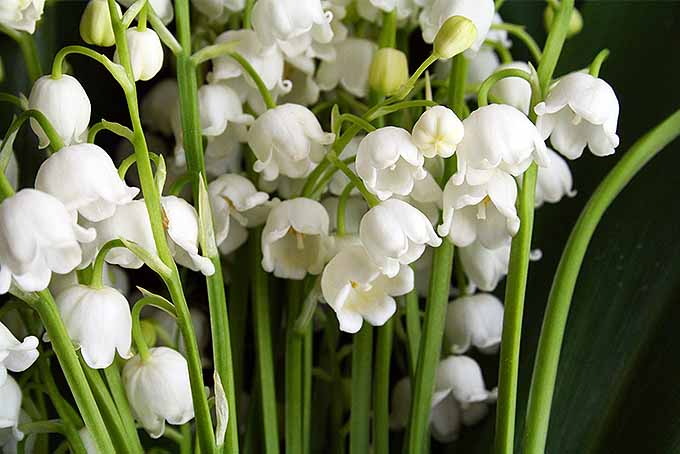
Let us know how lily of the valley is working in your garden, and share your advice and anecdotes in our comments section below!
And for even more on adding beautiful spring color and fragrance to your garden, you can check out some of our other flower growing guides such as:

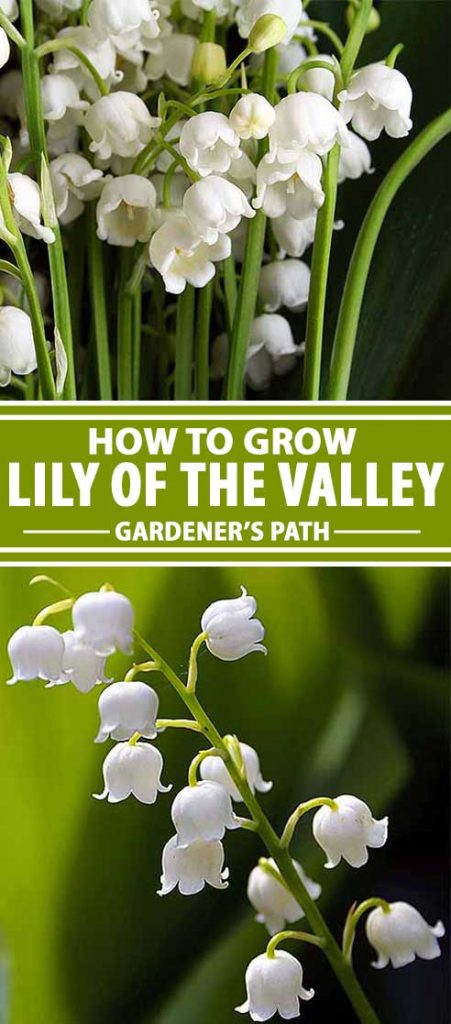
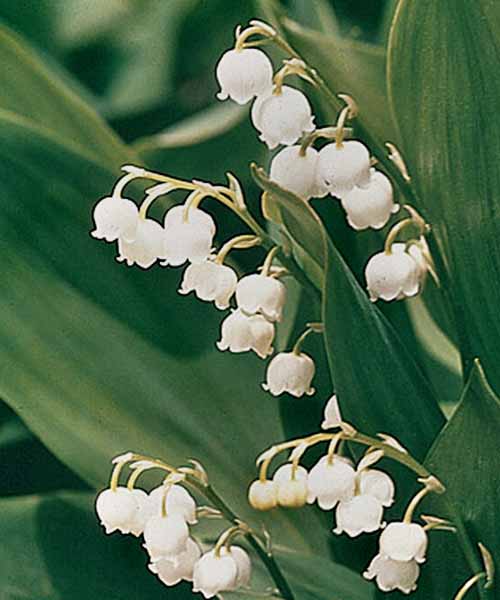
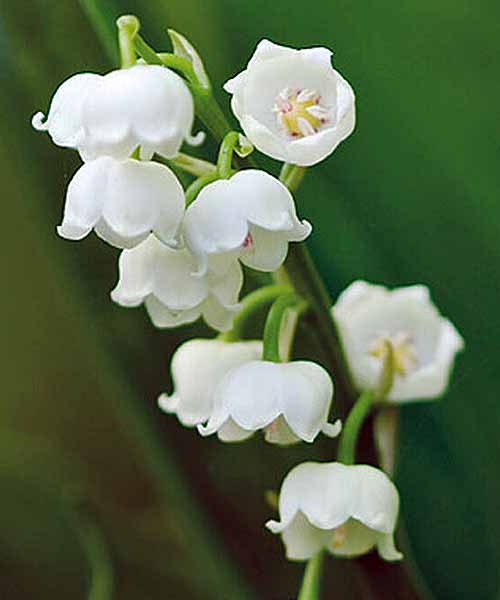
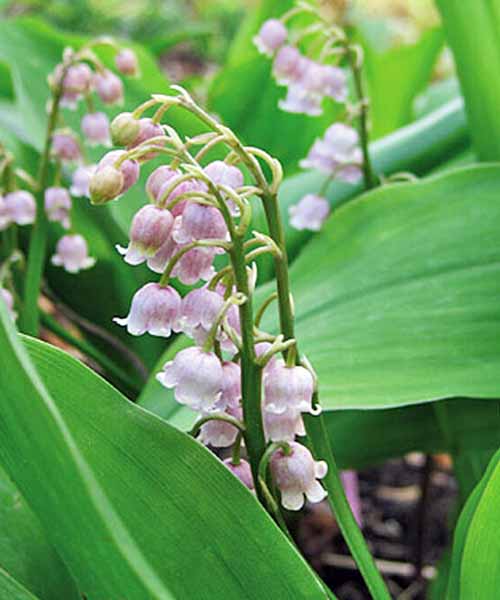
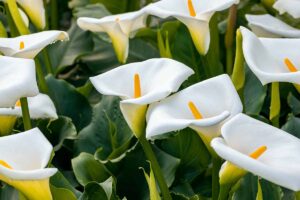
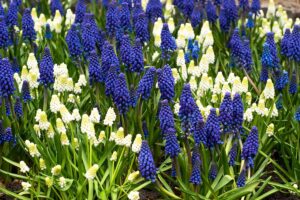
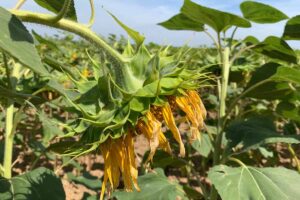
You are pretty impressive with your detail and enthusiasm when writing about these incredible species.
Thanks, Amy! I appreciate you taking the time to share your thoughts and kudos!
Can you identify the plant in my hand? It has a green stem, a few petals and a red center… among other things
Growing lilies is one of the most interesting jobs, for me this is the most beautiful flower in the world.
I loved your article, I have been trying for years to grow Lily of the Valley and they always seem to fail. Today a lady I met in the Lowes Garden Center gave me ALL of her Lily of the Valley plants, they are beautiful and I have the perfect place in my yard to plant them and I am 100% positive that they will flourish and become a most wonderful addition to my gardens. I am so excited to have them and so grateful to this lovely lady for just giving them to me. There are still good people… Read more »
Good people abound, when we find them, but I think you’re more apt to discover them outdoors and in the garden than anywhere else!
Be extremely caution with this plant. It is very invasive and will overtake everything unless it is contained with a border that goes into the soil at least 18 inches. The aroma is, however, unbelievable.
Hello! I ordered some Lily of the Valley seeds. I’m wondering if I can plant them as is (it’s now June), or start them in a pot in the house and then transplant, etc. Help! 🙂
You should be able to plant them more or less when you have them, but cooler temperatures are ideal for growing lily of the valley in any form. Once you’ve got the plants growing you can easily divide them by their rhizomes and watch the plants divide and conquer!
You mentioned using plastic barriers to control spreading. What exactly did you use and where would I find them? I also love my Lily of the Valleys!
The plastic barriers can likely be found at any garden center. It’s usually sold in coiled rolls, maybe 25-feet or so in length. The material is about eight inches tall and is easy to flex about and place it where you want it. You’ll find other materials available, but the plastic rolls are probably the easiest to work with, the most affordable, and the easiest to disguise.
I LOVE LILY OF THE VALLEY & HOPE TO BE ABLE TO GROW THEM..SOON.
WONDERFUL ARTICLE……
Thanks for reading, I’m so happy you enjoyed it!
Hello Matt, I love Lily of the Valleys and would love to plant them in the right of way under our Green Spruce tree (lower boughs 4ft off ground) for everyone walking by to enjoy their fragrance and dainty beauty. I would line the area with a soaker hose I could tie into for watering in drier parts of summer. Other landscapers have said flat out it won’t work. Do you agree it would be foolish for me to attempt? Live in zone 6 central IL. Also toying with the idea of dispersing a few daffodils or another contrasting color… Read more »
I don’t think it would be foolish to attempt, and the only way to find out is to try. I had a similar set-up, though I placed my plants beneath a yew hedge, and everything grew happily. The only issue I might see with the project is the lack of light for daffodils, but again, the only way to know for sure is to put them in the ground and see what happens. Daffodils may work. You could also try astilbe, or some colorful annuals; I am a fan of planting annuals in these scenarios because you can mix up… Read more »
I’m enjoying reading the guides you put together Matt. I get to learn about flowers and plants that otherwise I might not. I didn’t realise how poisonous they were so will be extra careful if I spot them on any woodland walks. It’s good to hear you got the plants in your garden under control. It’s not entirely the same, but currently I’m battling bindweed in my garden. It returns every year, even though every year I think I’ve won! I think it takes refuge in my neighbours garden. Anyway, thanks for sharing all of your knowledge on Lily of… Read more »
I’ve been putting together a list of poisonous and dangerous plants to grow in a garden, kind of a “hands off!” display. I might include lily of the valley in there! Weeds like bindweed are awful. I deal with a combination of that and mock strawberry at one property and it’s the only time I doubt my sanity. Except when listening to modern music. Outside of digging out as much root as you can, I’ve found a “hand wick” application of glyphosphate to be effective. Wear a protective vinyl glove and put a disposable cotton glove over it. Dip your… Read more »
Hi, Matt! Loved this article. These are my favorite flowers of all time and I FINALLY have the perfect yard for them with lots of shady spots under big trees. Is it better to plant bulbs in the late fall or plants in early spring?
Huzzah for the perfect yard!
I am always a believer in fall planting. It gives the plants a chance to settle in to cooling temperatures rather than warming ones. Spring or fall could both work, but fall gets my vote!
This is an amazing article! Thanks so much for the nice combination of fun details and actual science (I’m a biologist) – that’s a rare trait to be able to combine those in such a fun and readable format, but really appreciated. Great pictures too!